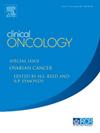Review of Radiotherapy Activity in Scotland, 2 Years Post COVID
IF 3
3区 医学
Q2 ONCOLOGY
引用次数: 0
Abstract
Aims
Now that the world has returned to normal following the COVID-19 pandemic, there are concerns that the pandemic has had a negative, ongoing effect on cancer care. This study aims to investigate the impact of the COVID-19 pandemic on radiotherapy services in Scotland.
Materials and methods
Detailed quantitative data of radiotherapy activity at our centre were collected from 01/04/2021–31/03/2023, which cover the second and third ‘post-COVID’ years. Differences in total/mean weekly radiotherapy courses, dose and fractionation patterns, and treatment intent for all treatment sites were compared to data from the year before the COVID-19 pandemic and the first year of the COVID-19 pandemic (01/04/2019–31/03/2021).
Results
Compared with the first year of the COVID-19 pandemic, the total number of radiotherapy courses increased from 6240 to 7899 (+32%) and 8188 (+35%) for the second and third years, respectively. Average weekly radiotherapy courses (AWRC) delivered increased from 120 (standard deviation [sd ± 15) during the COVID-19 pandemic to 152 (sd±15) and 157 (sd±19) in the two following years. In the two years post the COVID-19 pandemic, the total number of radical treatments increased from 5470 to 5912 (8.1%) and the total number of palliative treatments decreased from 2429 to 2206 (-9%). During the COVID-19 pandemic, a significantly greater reduction in radiotherapy utilisation was observed for females (3750-3156; -16%) than for males (3090-2839; -8%). In contrast, the two years post the COVID-19 pandemic have seen a significant increase in the number of women, with the total number of patients increasing to 4813 and 4860 (65–69%), receiving radiotherapy compared to male patients, with the total number of patients 3086 and 3256 (9–15%), respectively.
Conclusion
The two years post COVID-19 pandemic have seen a significant increase in radiotherapy activity compared to the first year of the COVID-19 pandemic and the year prior. The largest recoveries in radiotherapy delivery post the COVID-19 pandemic were observed in breast, cervical, rectal, and prostate cancer. Contrarily, a decrease in radiotherapy delivery was observed in patients with lung cancer. The increase in radiotherapy activity can likely be attributed to COVID-related suspensions of diagnostic tests, surgeries, and cancer screenings being reinstated.
COVID后2年苏格兰放疗活动回顾
尽管2019冠状病毒病大流行后世界已恢复正常,但有人担心,大流行对癌症治疗产生了持续的负面影响。本研究旨在调查COVID-19大流行对苏格兰放疗服务的影响。材料和方法收集了2021年4月1日至2023年3月31日期间我中心放射治疗活动的详细定量数据,涵盖“后covid”第二年和第三年。将所有治疗地点的总/平均每周放疗疗程、剂量和分割模式以及治疗意图的差异与COVID-19大流行前一年和COVID-19大流行第一年(2019年4月1日- 2021年3月31日)的数据进行比较。结果与新冠肺炎大流行第一年相比,第二年和第三年放疗总疗程分别从6240次增加到7899次(+32%)和8188次(+35%)。平均每周放射治疗疗程(AWRC)从COVID-19大流行期间的120(标准差[sd±15))增加到随后两年的152 (sd±15)和157 (sd±19)。在2019冠状病毒病大流行后的两年中,根治性治疗总数从5470例增加到5912例(8.1%),姑息性治疗总数从2429例减少到2206例(-9%)。在2019冠状病毒病大流行期间,观察到女性放疗使用率显著下降(3750-3156;-16%)高于男性(3090-2839;-8%)。相比之下,在新冠肺炎大流行后的两年里,接受放疗的女性人数大幅增加,患者总数分别增加到4813人和4860人(65% - 69%),而接受放疗的男性患者总数分别为3086人和3256人(9% - 15%)。结论与新冠肺炎大流行第一年和前一年相比,新冠肺炎大流行后两年的放射治疗活动显著增加。2019冠状病毒病大流行后,乳腺癌、宫颈癌、直肠癌和前列腺癌的放疗复发率最高。相反,在肺癌患者中观察到放射治疗的减少。放疗活动的增加可能归因于与新冠肺炎相关的诊断测试、手术和癌症筛查的暂停。
本文章由计算机程序翻译,如有差异,请以英文原文为准。
求助全文
约1分钟内获得全文
求助全文
来源期刊

Clinical oncology
医学-肿瘤学
CiteScore
5.20
自引率
8.80%
发文量
332
审稿时长
40 days
期刊介绍:
Clinical Oncology is an International cancer journal covering all aspects of the clinical management of cancer patients, reflecting a multidisciplinary approach to therapy. Papers, editorials and reviews are published on all types of malignant disease embracing, pathology, diagnosis and treatment, including radiotherapy, chemotherapy, surgery, combined modality treatment and palliative care. Research and review papers covering epidemiology, radiobiology, radiation physics, tumour biology, and immunology are also published, together with letters to the editor, case reports and book reviews.
 求助内容:
求助内容: 应助结果提醒方式:
应助结果提醒方式:


